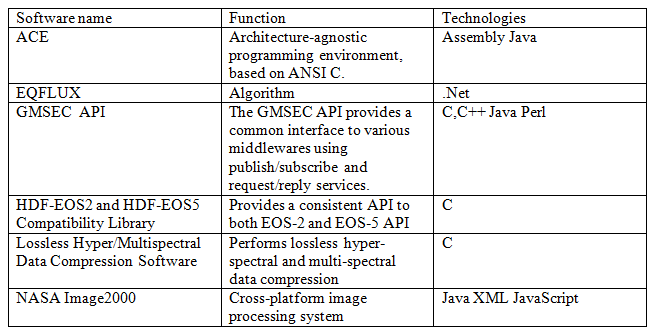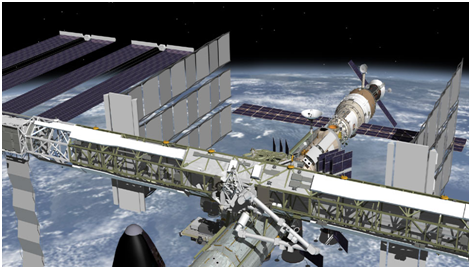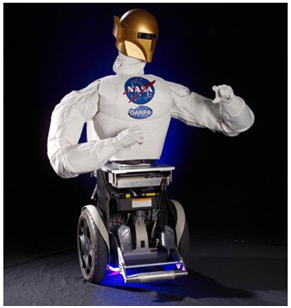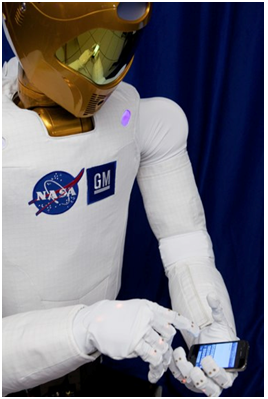Are you tired of living on this polluted Earth??????

How about flying into space? Sounds interesting isn’t it? Have you ever wondered how does a human survive in space? How does he communicate with people on earth? How does he sleep in zero-gravity? What’s life like for an Astronaut living in space? What does he eat?
Come on then let’s fly up into the space.
The International Space Station (ISS) is a space station or a habitable artificial satellite in low Earth orbit. The ISS serves as a microgravity and space environment research laboratory in which crew members conduct experiments in biology, physics, astronomy, meteorology and
other fields. The station is suited for the testing of spacecraft systems and equipment required for missions to the Moon and Mars.
OXYGEN & WATER
Oxygen comes from process called electrolysis.
Water Recycling System (WRS) reclaims waste water from the fuel cells,from oral hygiene and hand washing or by condensing humidity from air.
FOOD
TYPES OF FOOD:
The food system consists of 3 different supplies of food:
1. Daily Menu
2. Safe Heaven
3. Extra Vehicular Activity (EVA)
1. DAILYMENU
selected based on:Commonality to everyday eating and Nutritional content.
The Daily Menu food supply is based on use of frozen, refrigerated, and ambient foods.
2. SAFE HEAVEN
This food system is provided to sustain crew members for 22 days in emergency operating conditions (resulting from an on-board failure).Goal of this system is to utilize a minimal amount of volume and weight.
3. EXTRA VEHICULAR ACTIVITY (EVA)
EVA food consists of food and drink for 8 hours ( 500 calories of food+ 1 liter water) for use by a crew member during Extra Vehicular Activity. EVA water and food containers are cleaned and refilled.
SLEEPING IN SPACE
Since astronauts are weightless in space they can sleep in any orientation .They have to attach themselves to a wall, a seat or bunk bed inside the crew cabin. Crews usually sleep into sleeping bags.They sleep for 8 hours as on earth.
CLOTHES IN SPACE
Astronauts wear various types of clothing for all aspects of mission to space launch , crew members can choose the clothes they will wear in space. It is expensive to take supplies into space since no washing machine is available.
FITNESS & EXERCISE
On an average astronauts exercise 2 hours per day. Three specially designed equipment’s used are: Resistance exercise device, Treadmills with vibration isolation system, Cycle ergometer.
LINUX IN SPACE
The FlightLinux , a linux operating system was used in spacecraft onboard computers. No downloadable code is available for FlightLinux. Linux is stable and reliable, so it is being used. The various flavours of Linux, such as RedHat and Scientific Linux are used.
The European Space Agency’s Beagle 2 lander used Linux for its Mission Control Software and Mission Planning Software applications. NASA is using Linux in its newest and most powerful supercomputer.
The Columbian Supercomputer contains 10,240 Intel Itanium 2 processors and is used to run aeronautics, science, and engineering projects in the labs.
Linux is also used for research and development projects. The Personal Satellite Assistant is a self-propelled communications, monitoring and support device that is used on the station or on another ship and the PSA prototype runs Linux. The Extra-Vehicular Activity Robotic Assistant is another astronaut assistant that uses Linux. This is a wheeled vehicle that would help on the surface of the moon, Mars or other body.
The United Space Alliance manages the computers aboard the International Space Station in association with NASA.
Even if an astronaut gets a virus infected laptop in space, Linux will essentially immunize the ISS against virus infections.
The crew use an OpsLAN to perform day-to-day activities, such as viewing stock inventory, controlling scientific experiments or checking their current location. The applications used are re-written to work on Linux.
NASA and Space ground stations use Linux. DNA-sequencing lab technicians use Linux.
ROBOTICS IN SPACE
Robonaut 2, NASA’s Humanoid Space Robot:
Robonaut 2, a robot designed to eventually help astronauts by taking over some of their duties on the International Space Station. R2, as NASA calls it, is currently legless with its torso attached to a support post in the orbiting outpost.
Currently, astronauts on the space station perform experiments and test with an R2 unit that is locked in a stationary position inside the orbiting laboratory. Once Robonaut 2 receives its legs in 2014, the robot is expected to gain the ability to move about the station. Ultimately, engineers hope R2 will be able to perform repetitive tasks inside and outside of the station, freeing up the astronauts for more complicated work.
Robonaut2 using an iphone.
TECHNOLOGIES USED IN SPACE STATION:
 So are you ready to fly into space??…….
So are you ready to fly into space??…….
Reference links:
www.nasa.gov
Space food
Robonaut



